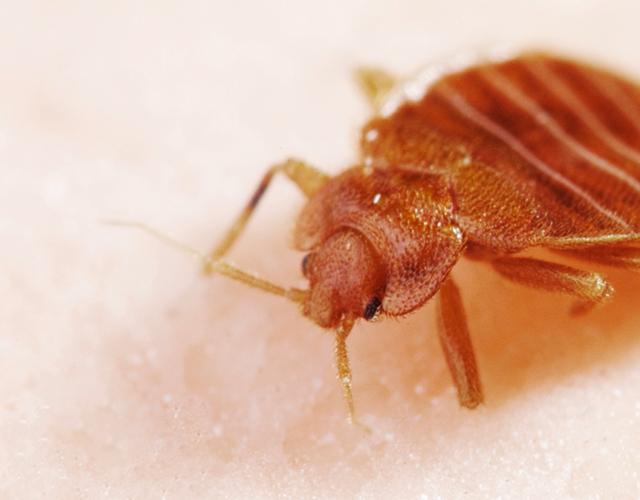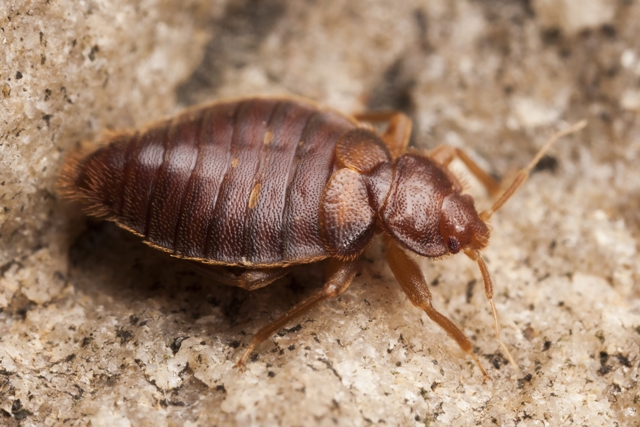What to expect from Lloyd Pest Control Services Ltd. if you have bed bugs.
 Think You Have Bed Bugs? Schedule an Inspection!
Think You Have Bed Bugs? Schedule an Inspection!
An initial inspection is done by a licensed technician from Lloyd Pest Control Services Ltd. to identify and confirm a bed bug problem. Once confirmed, details of the findings will be discussed and a treatment time and date will be agreed upon. If this is a multiple-unit dwelling, such as an apartment building or townhouse complex, your unit may be targeted for inspection and/or treatment measures. The reason being you are in close proximity to a known affected unit. This does not mean your unit will become infested, but it is very important to protect you and contain the possibility of the problem spreading. It’s best to be cooperative for everyone’s benefit.
Bed Bug Facts
They’re back. In recent years, airline routes have shrunk the planet to the point that every single bug in the world lives within a 24-hour flight of major cities. Additionally, the regulatory loss of long-lasting insecticides has allowed the once under-control bed bug to make a significant comeback. With the numbers of sightings in the United States and elsewhere now doubling every year, bed bugs are again proving to be a difficult and not so uncommon pest.
Bed bugs, as the name implies, are commonly associated with areas where we sleep. These insects lay dormant during daylight hours in small cracks and crevices, coming out at night to feed on blood. Bed bugs often hide near bedding areas, but can move more than 100 feet to obtain a blood meal so your relaxation areas where you watch TV or browse the internet are also vulnerable. Peak activity occurs between midnight and 7:00 a.m. The bite of a bedbug is painless, but approximately 50% to 70% of people develop an allergic reaction to the saliva injected by the bugs as they feed. The reaction usually results in red, swollen and itchy skin.
Adult bed bugs measure only an eighth of an inch in length, and are reddish-brown in color, with oval-shaped and flattened bodies. The immature nymphs resemble the adults but are smaller and lighter in color. Nymphs must molt five times before maturing and require a blood meal between each molt. Females can lay about five eggs a day and up to 500 in a lifetime. Eggs take 7-10 days to hatch. Without the aid of magnification, newly hatched nymphs are hard to see, and they are small enough to crawl through the stitching hole in a mattress. Development progresses from egg to adult in 30-60 days, under normal conditions (it can take much longer if adequate food is not available.) If a blood host is not found, newly molted nymphs can survive close to two months, and adults can survive for an entire year without feeding.
Bed Bug Control
Control of the bed bug is one of the most difficult challenges facing the pest control industry today. In the absence of long-lasting pesticides, pest technicians are forced to rely on new techniques and technologies, and some old-fashioned problem-solving skills. Proper bed bug control should always start with a detailed inspection. Bed bugs will hide where you would least expect – and, for the most part, only a trained professional will be successful in finding them. The application of targeted residual compounds, contact insecticides and monitoring devices is our method of choice. It is labour-intensive and time-consuming, but in our opinion, has resulted in successful outcomes time and time again.
If the homeowner budget permits before an initial treatment and three weeks after the last, it is helpful to deploy the use of steam cleaners using high heat and low pressure settings. The mattress, box spring and all carpets plus any sofas or fabric chairs should be steamed. This, too, is a time-consuming process, but steam kills all stages of bed bugs.
Length of Time for Treatment
The length of time it takes to treat a unit/home for bed bugs varies on the size of the unit/home, on the amount of furnishings to be treated and the severity of infestation. Approximate treatment times vary from 30-45 minutes for a bachelor apartment or a student resident room to 3-4 hours or more for single detached homes.
Be Honest with Us for Most Effective Treatment
Be honest – if you have been treating the problem yourself before we got involved, let us know and then do not chemically treat your home once a pest management company has been hired. If you suspect you have bed bugs, tell us why. If you will be throwing out your mattresses, box spring or other infested items, please be advised to wrap it completely in plastic before carrying it through your home for disposal and slash fabric so it will not be reused.
At Least Three Treatments Will Be Required
After inspection, three treatments minimum are most often recommended – the initial treatment and two follow-up treatments in order to obtain the best results. The technician will advise you if for any reason he feels less or more treatments are required. All occupants, including pets, will need to be away from your home for six hours each time a treatment is done. Cover and consider unplugging any fish tanks if applicable. If you have any serious health conditions, consult with your doctor and follow his/her recommendations.
Follow-up treatments will be scheduled two to three weeks apart. We will call to arrange the next time and date. If you have not heard from us within this time frame, please call us.
Occupant Preparation for All Scheduled Treatments
- Do not dismantle the bed (take apart). Doing so may scatter and change existing hiding places, making control more difficult.
- Heavily infested bed components (example, box spring, mattresses, head/footboard, and bed skirts) may need to be discarded. The technician will advise you of this.
- In order to do a thorough treatment, the occupants should strip the bed of sheets, blankets, pillows, etc., to expose the mattress for inspection. Fold bedding in on itself to contain any bed bugs. Once removed, wash all bedding in hot water at a temperature of at least 120 degrees.
- Look through all bedroom drawers. Clean clothes should be put in a dryer at the highest temperature setting for a minimum of 20 minutes to aid in the elimination of concealed insects. Store all clothes and drawer contents in tightly sealed plastic containers or tied garbage bags for temporary storage within the room throughout the treatment schedule.
- Leave empty all dresser and nightstand drawers. They will be inspected and treated during each treatment. Empty all shelving and clear floor areas of all closets (Example, in bedrooms, hallways, and bathrooms including any items on hangers). Exposure of the cracks and crevices of shelves and access to closet baseboards is what we are interested in inspecting and treating. Bed bugs hide in these types of places.
- Take all pictures, posters, etc., down from walls. Leave them in the room taken down from. Lean framed pictures back facing out for inspection.
- Upholstered chairs and sofas will be inspected and treated. Please keep these areas clear.
- Pull all furniture throughout the home a minimum of 6 inches to about one foot away from the walls. This allows access to the baseboards in the entire home.
- For first treatment, please remove all light switch covers and plug (outlet) plates. You may put them back on after treatment.
- Repair any loose wallpaper. Caulk all wall and wood cracks as they can provide additional hiding places for bed bugs.
Bed Bug Points of Interest
- They feed approximately once per week on average.
- Females lay approximately 300-500 eggs in a lifetime, which is about 2-4 eggs/day.
- Eggs hatch anywhere from 7 to 15 days after being laid under optimum conditions.
- Once hatched, they are called nymphs and they will undergo five molts. Favorable conditions will provide for mature adults within 4-6 weeks.
It’s No Use Complaining; Do Your Part
 It is our intention for you to understand the importance of complete cooperation at each step of the process. Yes, it is a huge inconvenience and a lot of effort on the part of all participating. Complaining, blaming and looking for ways to do less than what is required serves no purpose. We need to work together to ensure the best result possible.
It is our intention for you to understand the importance of complete cooperation at each step of the process. Yes, it is a huge inconvenience and a lot of effort on the part of all participating. Complaining, blaming and looking for ways to do less than what is required serves no purpose. We need to work together to ensure the best result possible.
Occupant Responsibilities between Follow-Up Appointments
- Strip the bed regularly and launder all bedding at a temperature of at least 120 degrees.
- Please vacuum your home just before we do the initial treatment, and then vacuum again before we return to do our second and third treatment. When vacuuming, pay particular attention to seams, tufts and edges of mattresses and box springs of beds, as well as baseboards and bed frames. Using your vacuum’s crack and crevice tool, get down inside the arms and back of upholstered furniture and do the perimeter edge of wall-to-wall carpets.
- Always dispose of vacuum bag contents in a sealed trash bag.
- Keep a written report of any activity noted during the period between treatments and contact our office with your comments. Wait three to four weeks after final treatment before vacuuming again.
- It is important to keep clutter to a minimum. Dispose of as many unnecessary household items before treatment and continue those de-cluttering efforts between treatments. The fewer bed bug hiding places, the better.
- Before our first treatment and three weeks after our last, consider steam-cleaning (with low vapour and high heat) all carpets, bed mattresses and upholstered furniture. It is helpful for eliminating bed bugs and eggs that vacuuming or treatment might have missed.
- Consider purchasing zipped mattress covers for use after. Your cooperation is very important in obtaining success not only for your home, but in the case of multi-dwellings, that of your neighbour.
Have Questions or Concerns? Call Our Office!
Should you have any questions or concerns, please call our office in Oshawa. If it’s after hours, leave a message and we will call you back as soon as possible the next business day.
 How to Deal with Common Insects
How to Deal with Common Insects Customer Preparation Tips for Flea Treatments
Customer Preparation Tips for Flea Treatments
